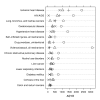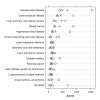Calculating expected years of life lost for assessing local ethnic disparities in causes of premature death
- PMID: 18402698
- PMCID: PMC2386472
- DOI: 10.1186/1471-2458-8-116
Calculating expected years of life lost for assessing local ethnic disparities in causes of premature death
Abstract
Background: A core function of local health departments is to conduct health assessments. The analysis of death certificates provides information on diseases, conditions, and injuries that are likely to cause death - an important outcome indicator of population health. The expected years of life lost (YLL) measure is a valid, stand-alone measure for identifying and ranking the underlying causes of premature death. The purpose of this study was to rank the leading causes of premature death among San Francisco residents, and to share detailed methods so that these analyses can be used in other local health jurisdictions.
Methods: Using death registry data and population estimates for San Francisco deaths in 2003-2004, we calculated the number of deaths, YLL, and age-standardized YLL rates (ASYRs). The results were stratified by sex, ethnicity, and underlying cause of death. The YLL values were used to rank the leading causes of premature death for men and women, and by ethnicity.
Results: In the years 2003-2004, 6312 men died (73,627 years of life lost), and 5726 women died (51,194 years of life lost). The ASYR for men was 65% higher compared to the ASYR for women (8971.1 vs. 5438.6 per 100,000 persons per year). The leading causes of premature deaths are those with the largest average YLLs and are largely preventable. Among men, these were HIV/AIDS, suicide, drug overdose, homicide, and alcohol use disorder; and among women, these were lung cancer, breast cancer, hypertensive heart disease, colon cancer, and diabetes mellitus. A large health disparity exists between African Americans and other ethnic groups: African American age-adjusted overall and cause-specific YLL rates were higher, especially for homicide among men. Except for homicide among Latino men, Latinos and Asians have comparable or lower YLL rates among the leading causes of death compared to whites.
Conclusion: Local death registry data can be used to measure, rank, and monitor the leading causes of premature death, and to measure and monitor ethnic health disparities.
Figures



References
-
- Institute of Medicine, Committee for the Study of the Future of Public Health . The Future of Public Health. National Academy Press; 1988.
-
- Institute of Medicine, Committee on Assuring the Health of the Public in the 21st Century . Future of the Public's Health in the 21st Century. National Academy Press; 2003.
-
- Centers for Disease Control and Prevention Updated guidelines for evaluating public health surveillance systems: Recommendations from the guidelines working group. MMWR Recomm Rep. 2001;50:1–51. - PubMed
-
- Murray CJL, Lopez AD, (Eds) A comprehensive assessment of mortality and disability from diseases, injuries, and risk factors in 1990 and projected to 2020 (The Global Burden of Disease and Injury) Harvard School of Public Health; 1996.

